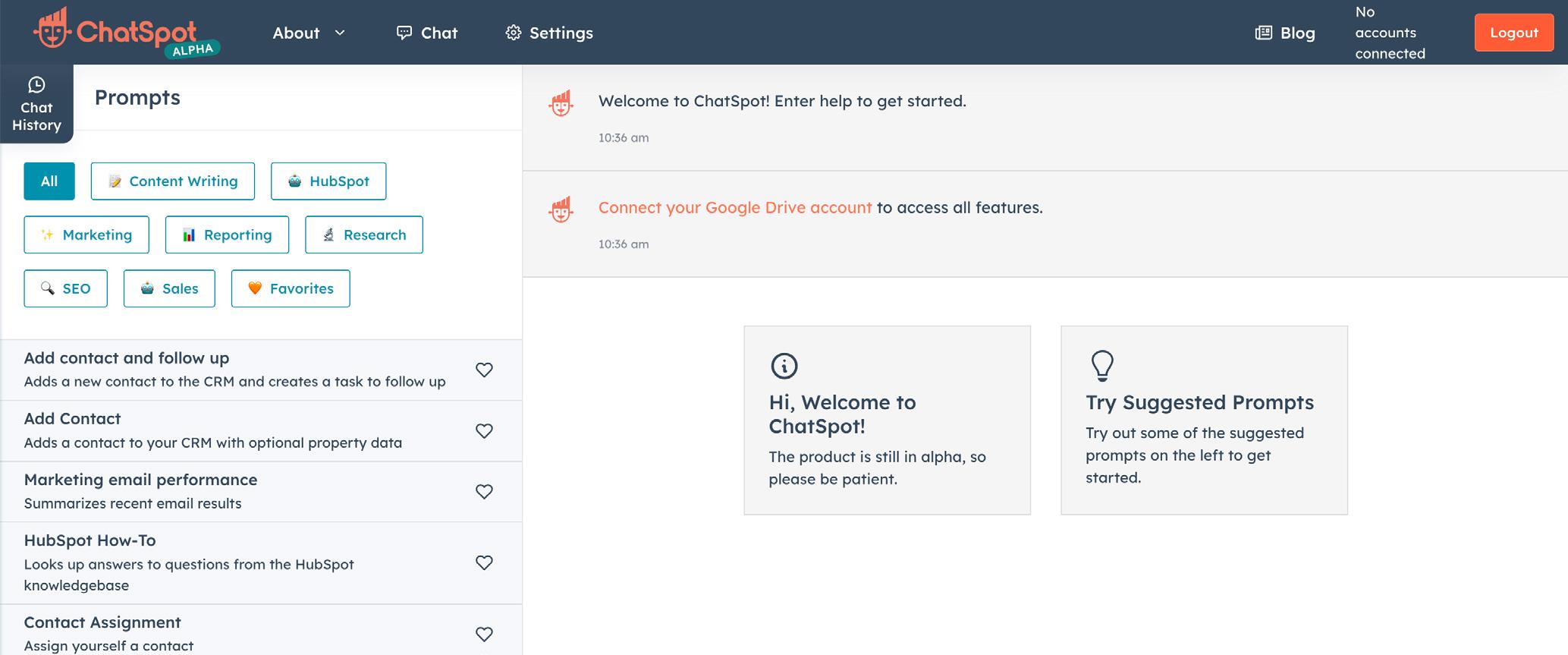AI Trends for Marketers
How AI is Changing Marketing and Driving Rapid Business Growth




Leaders are already seeing the power of AI technology for business growth. Our latest survey data revealed that 68% of marketing leaders at the director level and above say that if AI and automation were fully implemented in their company, the business would see unprecedented growth. And 62% of business leaders say their company has already invested in AI and automation tools for their employees to leverage: Of those, 71% report positive ROI, and 72% say AI and automation make their employees more productive.
AI technology is evolving quickly, and there’s much to learn. Experience with AI tools and advanced prompt engineering (structuring AI requests strategically) are rapidly becoming indemand marketing skills, and AI is opening up new dedicated roles. By learning to chat with an AI tool, marketers unlock a whole world of insights, ideas, and enormous time savings. The top four uses of generative AI among marketers are:
Analyzing/reporting on data
Learning how to do things
Conducting research
Read on to explore the trends in AI for marketing, along with insights from leaders in tech on what these trends mean for business growth.
In 2023, the average marketer is working on fve campaigns at a time, and handles a total of seven campaigns each quarter. That kind of workload requires constant multitasking, re-prioritizing, and delegation± and even then, it can still simply feel like too much.
Part of why AI has become so popular among marketers is that they’ve realized there’s a clear diference between high-impact work (like creative brainstorming, strategizing, project execution, and people management) and low-impact work, which include menial, mindless, or repetitive tasks. The high-impact work is rewarding and satisfying to do. The low-impact tasks? Not so much.
90% of marketers
say AI and automation help them spend less time on manual tasks, spend more time on the parts of their job they enjoy most (80%), and more time on the creative aspects of their role (79%).

Marketers spend an average of fve hours a day on manual, administrative, or operational tasks — think keyword research, data cleanup, list building, formatting blogs in a CMS, and analyzing raw data to pick out key insights. Many of these tasks are done within powerful platforms that are as user-friendly as possible, but even so, it’s a lot of repetitive work.
AI tools give marketing teams:
By implementing an AI tool, the average employee saves almost 2.5 hours a day on those menial tasks. They’re still getting it all done, but in half the time. OR
12.5 hours back per week
25-26 additional working days in a year
AI and automation can free up nearly a month of additional work time. That’s a lot of time that marketers can spend on the truly human tasks on their plate, like strategy and planning, creative work, and people management.

Thirty-fve percent of marketers say they use AI and automation in their role, and it goes up to 54% for bloggers and SEO specialists. The question of what counts as AI or automation isn’t always clear, so usage is likely much higher. For example, Grammarly is an AI tool, but many might not yet see it that way.
Speaking of, here are some of the top AI tools being used by marketers.
What types of AI marketing apps are marketers using?





The most popular AI tool for marketing is Compose AI (18%), followed closely by Jasper (17%) and Copy.ai (16%). Here’s what some of the most popular AI tools for marketers can do.
ChatGPT
Created by Open.ai, the most famous AI chatbot of them all. In just two months, ChatGPT reached 100 million users.
Jasper
A generative AI chatbot focused on blog writing.
Google Bard
A conversational generative AI tool based on Google's LaMDA (Google's conversational AI model) that can summarize web pages, explain code, and boost productivity for any use case.
ChatSpot
HubSpot’s all-in-one AI tool for marketers: It takes all the information in a user’s HubSpot CRM and combines it with the power of ChatGPT, DALL-E 2, Stable Difusion, and keyword research.
Kive.ai
Kive.ai focuses largely on visuals and helps designers, brand managers, and art directors organize visual libraries and create AI-powered mood boards.
HubSpot AI Content Assistant
HubSpot’s AI Content tools include a blog writer, paragraph rewriter, email writer, and content writer. It can help you take care of creating a frst draft of all your copy initiatives.
10Web
This AI website building platform helps marketers and bloggers build Wordpress sites at lightning speed — and helps improve UX and solve page speed issues.
SEO.ai
This tool is built to accelerate keyword research and help SEO-focused marketers do more, faster, and more efectively.
Marketers say generative AI is most helpful for creating social media posts, product descriptions, and responding to emails — but here’s what they’re trying, all throughout the content marketing ecosystem, from planning to analytics.
AI is the best way to get the ball rolling when brainstorming. It’s time to get rid of the curse of the blinking cursor.
How are marketers today using generative AI?
To get ideas and inspiration
To conduct research
learn how to do things
Tools like ChatGPT quickly parse all the information available online and present it in a conversational fashion, making it incredibly easy to digest.
Rather than clicking around on several Google results, and scrolling past ads and media to get to what you want, AI tools help marketers fnd the most relevant information, and they present it clearly and succinctly. Of course, these tools are far from perfect and can often provide incorrect information. But as a starting point, and as a way to get ideas rolling and acquire basic knowledge on a new topic, AI is both easy and fun to use.
When using AI tools, prompt-writing is an art and a science. Try several variations on your prompt before turning to a new solution — the more specifc, the better the result.
One very popular prompt for research and learning is, “Explain ____ to me like I’m fve years old.” It makes for an excellent starting point for any new initiative.
A new marketer at a business that provides local washing machine repair services wants to check out the competitive landscape and fnd out if competitors invest in social media. The marketer can simply ask an AI tool like ChatGPT to “show me the most popular options in New Jersey for washing machine repair. List them in a spreadsheet with their social media links, follower counts, and their average Google reviews score.”
In a fash, the spreadsheet is populated, and the marketer has a sense of the competitive landscape in their local industry. Then, they can keep digging to fnd out how they can best market the business to stand out and gain more customers.
SEO planning and keyword research is some of the most repetitive, time-consuming work that content marketers do on a regular basis. Keyword research tools like Ahrefs, Moz, Google Ads Keyword Planner, and Mangools are extremely powerful, but it takes time to sift through keyword ideas, create spreadsheets mapping out keyword research for a larger campaign, and track how various pages of your website are ranking for various keywords. AI can help with all of that: 82% of marketers say generative AI has already impacted the way they plan to create content in 2023, and 69% say it’s important to their overall content strategy.
use AI to automate timeconsuming SEO tasks. 37% of marketers
Time-consuming SEO tasks include longtail keyword mapping, internal link building, and SERP comparisons, and 35% of marketers use it to create an SEO-driven content strategy.
Generative AI helps bloggers optimize their website for SEO and improve UX, which helps posts rank better. AI can help marketers create a whole SEO-driven content strategy. But if you want to get started, just try seeing how much time you save by automating a few manual keyword research tasks.
say AI and automation have impacted their SEO strategy for 2023. 84% of bloggers/SEOs
Marketers say that AI and automation are very efective at:
Aligning web content with search intent
the user experience on their site
In terms of overall sentiment, 44% foresee a positive impact on their SEO strategy, 51% foresee no impact at all, and just 5% see a negative impact.
Learn about prompt engineering.
Learning how to ask AI the right questions is an important step in getting the SEO keyword information that you need from it.
Try various queries.
If you hit a dead end or receive an answer that doesn’t feel right, try again. Get a little more specifc or be a little more descriptive.
Go in with a goal, but start small. Try starting by asking for the keyword volume of keywords related to a topic you’re considering writing about. Once you’re more comfortable with the system, you can try out more complex queries like “build a content strategy for a company that does _____”.
Be ready to fact check your SEO fndings. Generally, AI isn’t going to provide a one-and-done perfect answer to every prompt you send. That means it’s a good idea to have one window open with your usual keyword research tool to sense-check any keyword volumes or rankings that feel wrong or unusual.

Creating exceptional content that engages, converts, educates, and truly stands out online is a time-consuming process. But it’s the details that take a piece from good to great. AI content marketing tools can help get you from a blank page to a strong outline, then a piece in good shape. Then, marketers and copywriters can work their magic and turn the draft into a valuable piece of brand content.
How do marketers use generative AI today?
Marketers using generative AI to make content save an average of 3+ hours per piece.
As we all know, generative AI can’t replace the skills of a professional writer. But it can create a helpful starting point that saves writers hours, letting them create more content, faster.
How do marketers use AI to write?
Make minor edits to the generated text before publishing
AI content is not complete enough to publish on its own. 96% of the time
When using generative AI to write copy, just 5% of marketers use it to write entire pieces of content for them. About one-third (35%) lean on generative AI to get ideas or inspiration, another third use it to get an outline down, and 25% use it to write a few paragraphs that they then expand on.
Marketers often write blogs and articles with particular goals in mind, whether that’s driving web trafc, generating MQLs, or growing a subscriber list. And AI can help create content that does its job better. Sixtythree percent of marketers using generative AI to make content say it performs better than content made without generative AI. Eighty-nine percent of marketers using generative AI to make content say it improves the quality of their content.
Once you’ve stood up a content program, scaling content can be challenging, especially on already timestrapped teams. When the goals are consistently growing but the team budget doesn’t always follow suit, AI can help scale content, creating more content more quickly.
83% of marketers
say that AI helps them create signifcantly more content than they could without.
Learn how to use AI to grow your content marketing operations and generate more business.
Grab the guide
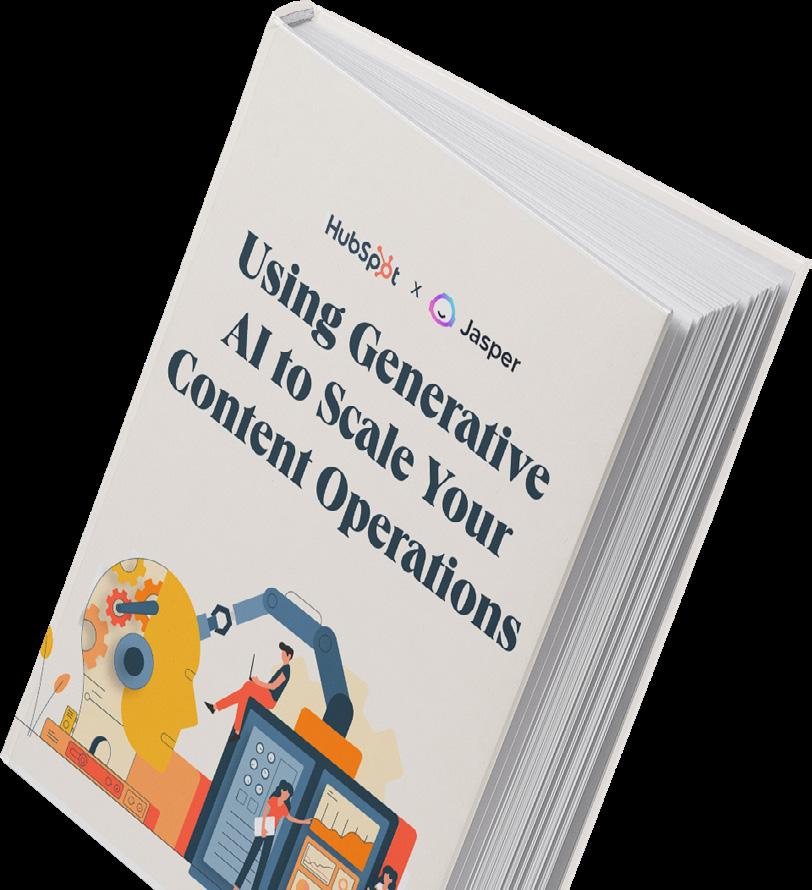
AI is also incredibly helpful for the often tedious process of personalization and localization. Taking the same piece of content and tweaking it to speak to specifc audiences or regions takes time, but AI can help. Get a head start on changing American English spelling to Canadian English, or quickly scan documents and change local currencies. Remember — localization is far more nuanced than simply changing spelling and swapping out cultural references.
“AI tools are great for enabling, assisting, and augmenting human work. But creativity and judgment are where humans distinctly shine.
Now, global marketers, imagine being the person who has to come up with the creative advertising headline in another language. But we have machine translation tools for that, right? Actually machine translation tools have long been a commodity in the translation space (for many decades), but have not yet displaced human translators.
The same will hold true for all human creatives, in my opinion. May the most creative (and tech-assisted) human win.”

NATALY KELLY Globalization Expert
Finally, many marketers like to work backwards and use AI as an editing tool. Pasting a piece of content into a generative AI tool and asking it to check for spelling or grammatical errors is a helpful fnal test if you don’t have a second set of eyes to look over a piece. Same goes for simplifying text, or changing the tone or style — AI tools can do that in seconds.
HubSpot’s AI Blog Writer was created specifcally for content marketers to boost organic trafc and scale lead gen eforts.
Try it now
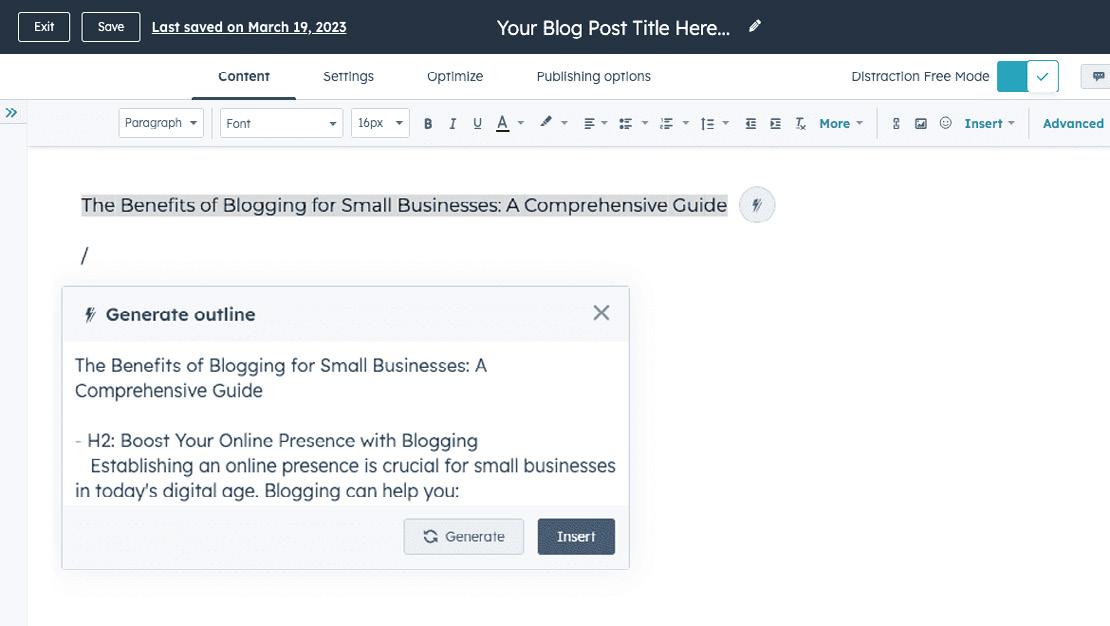
More than one in fve marketers (21%) use AI to summarize text into key points, which is important for repurposing content across channels. When your team has put weeks (or months!) of work into a new content ofering, like a report, a course, or a whitepaper, it’s infnitely more powerful if it’s repackaged and distributed across multiple channels. But it’s time-consuming to take a long form piece of content, pick out the key insights, and phrase promotional posts according to the needs of each channel. Promotional channels might include several social platforms, emails with diferent CTAs, and webinars and presentations — and can amplify content far beyond the original audience.
Generative AI marketing tools can help. Just paste the long form content (or a link to it) into your AI tool of choice, instruct it to generate a few promotional emails or social posts for diferent platforms highlighting the main takeaways, edit for style, and post.
AI can also help you write variations of similar text. HubSpot’s Paragraph Rewriter uses AI to reword text for you — so there’s no more copy-pasting across platforms. You can even select which tone you want, from friendly to professional and everything in between.

Turn blog posts into videos or podcasts, and vice versa.
Transform long-form content into short-form educational social media posts.
Add visuals to a long-form piece to share on social.
Build landing pages from email sequences or podcasts.
Get a head-start on localizing or editing content for new regions or audiences.
Turn product content into marketing promotional materials.
Take raw data and create data visualizations and reports.
Today, 31% of marketers use AI to create social media posts. While some social content and campaigns are inherently unique and require human creativity, some social posts are meant to tackle a simple objective — and those are the ones AI tools can help with.
What’s more, we know that content tailored to each social media site performs better, as opposed to just posting the same thing verbatim across all platforms. It’s time-consuming to rephrase each post and fnd new ways of getting a similar point across to various audiences — but AI can help make this process much quicker.
There are tons of diferent use cases for generative AI and social media — here are a few ways it can help.
1. Share a social media caption for Instagram and ask the AI to transform it into a more professional caption appropriate for LinkedIn.
2. Automatically create social media ads according to the specs for each platform.
3. Develop ideas on what to post on social based on your industry.
4. Generate ideas on how to create social posts that achieve a specifc goal (e.g., creating linkedin posts to get your audience to subscribe to a newsletter).
5. Create social media posts that announce new team members, new products, or any other noteworthy update.
Generate Social Posts for Every Platform and Audience — Instantly
HubSpot’s free AI Content Writer can help you generate social posts that strike the right tone for each platform and audience. Try it now

use generative AI to create and answer emails. 28%
We’re expecting that number to grow rapidly. Marketing automation, in the form of email fows and nurtures, triggers, and smart lists, has become commonplace for marketers at companies of all sizes. But now, with new AI-powered marketing automation tools like ChatSpot, you can build lists based on specifc behavioral criteria in moments.
Generative AI tools can help teams create marketing emails that promote sales, new products, promotions, and coupons — all while leveraging data from successful past campaigns. Marketers can focus on building the strategy behind their email campaigns (including choosing which customer segments to target and how), and editing the text and ensuring it fts brand guidelines for tone and style. With the time saved on writing marketing copy, marketers can build more elaborate campaigns that target a larger variety of specifc customer segments.
Learn more about how HubSpot’s free AI Email Writer can save your team hours.















































A B2B software company sells their employee scheduling platform to a range of small businesses. The company’s marketing team could spend hours crafting the copy for three diferent versions of a promotional email — one for restaurants, one for all beauty salons, and one for all medical ofces — or they could use an AI-powered tool like ChatSpot to create the draft copy for 10 diferent hyper-targeted emails for the following segments in a fraction of the time.
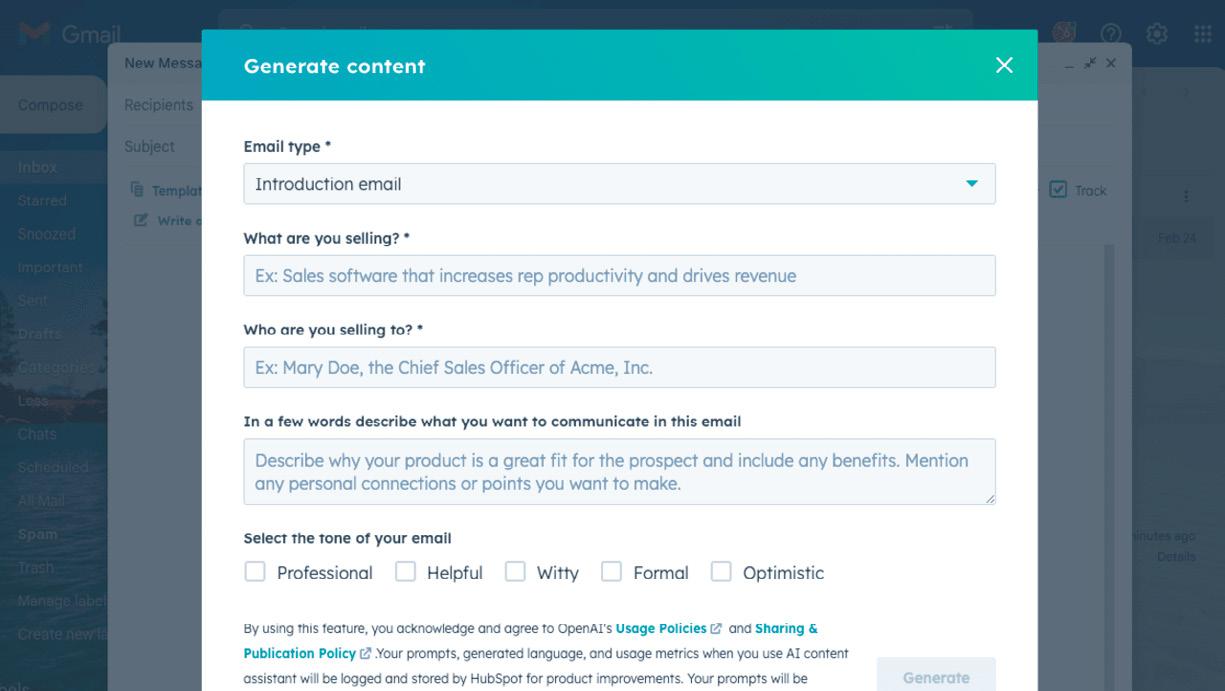
1. Restaurants that already have a scheduling tool
2. Restaurants that don’t yet have a scheduling tool
3. Nail salons that already have a scheduling tool
4. Nail salons that don’t yet have a scheduling tool
5. Hair salons that already have a scheduling tool
6. Hair salons that don’t yet have a scheduling tool
7. Primary care ofces that already have a scheduling tool
8. Primary care ofces that don’t yet have a scheduling tool
9. Dental ofces that already have a scheduling tool
10. Dental ofces that don’t yet have a scheduling tool
Then, the marketer just has to edit the copy, add links, and select the audiences through their CRM and email platform. The emails will be more targeted and more efective, and they’ll have been built in a fraction of the time.
Twenty-fve percent of marketers use AI to create product descriptions. Though typically, product marketing teams will do deep user research to fnd the best ways to describe their products, things can get monotonous if marketers use the same phrase over and over again in all their content.
AI rephrasing tools can help teams fnd new ways of getting the most important features of their products across — and who knows! You might just fnd an even better way to describe a feature.

Content marketers are often caught up in the task of creating more, more, more content — but it’s equally important to optimize the content you already have on your site. As content gets older, it becomes dated and less useful, and if you’re not keeping your content up to date, it will plummet down the SERPs.
37% of marketers
already use AI when analyzing blogs to provide actionable insights.
AI can help teams analyze and optimize their existing content libraries — especially if the AI tool is linked to their CRM.
You can ask AI to provide a list of underperforming articles, or articles that were published over a year ago and haven’t been updated. You can give it a link and ask it to show you which keywords it’s ranking for, and which ones need a boost. All of this information can be shared in seconds, and marketers can focus on actually optimizing the content and making their eforts go further.
use AI to analyze and report on data.
Creating quarterly reports about the performance of various content types, campaigns, and initiatives used to require hours, or even days. Data would have to be pulled and analyzed from various platforms by BI teams or data analysts, and the main takeaways would be spun into beautiful presentations by marketing channel owners. It was a process that required a lot of diferent skill sets and tools.
Now, AI tools can help teams pull and quickly analyze their channel data themselves — and ChatSpot can even build progress reports right into HubSpot. That way, BI teams can be available to tackle the really complex data they’re trained to manage, and they don’t need to waste their time helping out other teams with very basic asks.
You can even set up the system to send you quarterly reports automatically, right into your inbox.
Plus, any information generated by AI tools can be shown as a spreadsheet, a bar chart, or virtually any other standard format — all you have to do is ask.
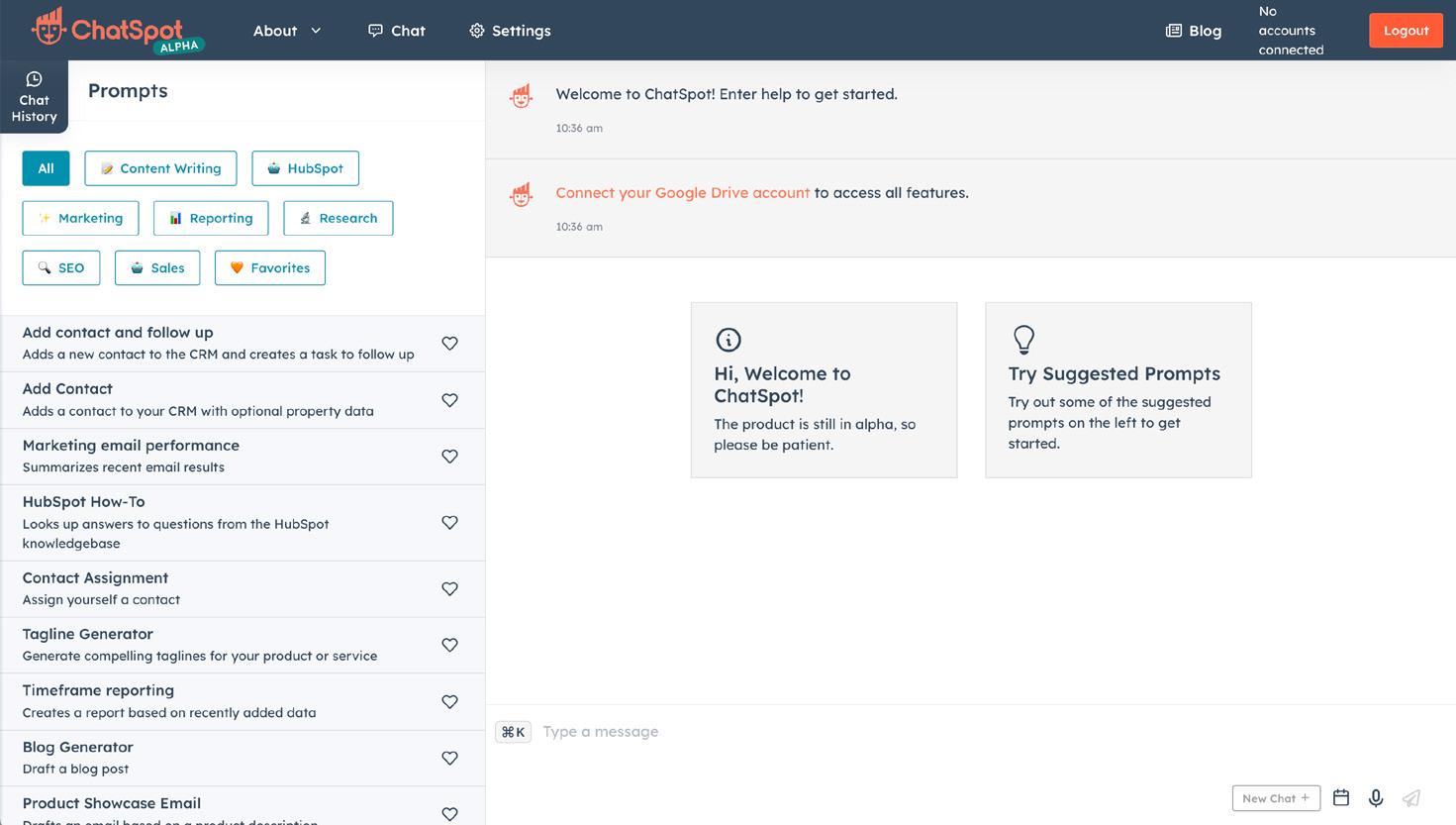

Artifcial Intelligence has revolutionized the way businesses operate and market their products and services. AI can help optimize marketing activities by providing insights into customer behavior and preferences, identifying trends and patterns, and automating processes such as content creation, customer segmentation, and more.
Before going all in on AI, take the time to establish your business needs and objectives. Then, invest in proper training and resources to ensure that you are using AI efectively and ethically. By doing so, your AI initiatives can achieve better results, save time and resources, and, ultimately, help you enhance your marketing strategy to better connect with your customers.
Here are four tips to help your team best use AI for marketing.

Start by identifying the areas in your marketing activities that can be improved by AI. This could be website building, personalized targeting, content optimization, or even chatbot assistance for customer support.
AI content generation can help you accelerate your content creation by 10X. However, while AI capabilities are advancing rapidly, they aren’t perfect just yet, and the human touch is still essential. Continue to factcheck information in articles and ensure that the messaging and tone are aligned with your brand voice.

TIP #2
With a market value of $9.32 billion, there is no shortage of AI tools available on the market today. But that can make it hard to research all the options and choose the right one according to your needs and budget.
Consider long-term implications of the AI tools you invest in, like whether the technology and infrastructure can evolve and scale with your business as it grows. Plus, there are tons of advantages of selecting a tool from a company with an active, invested community and helpful technical support.
Keep an eye on user reviews from reliable sources, like industry forums, Reddit, LinkedIn, etc. and fnd options that meet your team’s specifc needs.

TIP #3
Tex-to-text and text-to-image AI generators have taken the world by storm, in large part thanks to tools like ChatGPT and DALL-E 2. These tools use technologies like large language models (LLM), natural language processing (NLP), and artifcial neural networks to read human input, “understand” it, and generate the desired output.
As the main way that humans communicate with these tools, learning how to efectively use text-based prompts will become a superpower for using AI.
But, diferent tools are trained on diferent models and have unique use cases and quirks. Working with AI tools is like learning a new language (but much easier); it takes a little time and efort to learn how to communicate your needs and master generative AI prompt-writing.
For example when you want to generate an image, don’t just describe the image. Go to ChatGPT, ask it to create a prompt for a specifc type of image you have in mind, and then use that prompt for DALL-E or Midjourney.
To provide more value to customers and get a competitive edge, more and more existing platforms are leveraging AI to improve their services. Explore new AI features and capabilities within your existing marketing tech stack.
For example, social media platforms like Facebook and Instagram ofer AI-powered ad targeting and audience insights, while email marketing platforms like Mailchimp provide AI-powered recommendations for subject lines and send times.
By testing out these new features, businesses can gain valuable insights, automate existing processes, and ultimately enhance their marketing strategy.
If your team isn’t up-to-date on the latest AI-powered features, you’ll miss out on timesaving changes, and business growth opportunities.



AI tools have the potential to revolutionize the way we market brands, products, and services to customers. But, like with anything in life, the more you put in, the more you get out. To stay ahead of the competition and achieve better results, understand your AI tools’ benefts, potential, optimal use cases, and limitations for your marketing needs.
Explore 10Web's AI Website Builder to generate customized websites with 90+ PageSpeed score
Build and host a website 10X faster with AI
Get AI generated content and images
Customize with Elementor based editor
Get a 90+ PageSpeed score with Booster
Get started

Since AI-powered technology has developed so quickly, it’s understandable for even the most agile and innovative marketers to have some hesitations around diving in head-frst.

The #1 challenge cited by marketers is that AI tools sometimes produce inaccurate information. Almost half of marketers using generative AI say they have received information that they know is incorrect — and, perhaps more concerningly, only 27% are very confdent they would know if the information were inaccurate.
Fact-check information from AI tools, and cite all sources of information in your content.
It’s also important to consider bias: AI tools are known to sometimes serve up biased information. If the teams building AI models aren’t diverse enough across all types of life experiences, the information fed into it will have inherent bias.
AI4ALL is an initiative that works to feed AI a broad range of content, so it can learn to pull from source material that refects the diversity of our world.
Another heavily cited hesitation around adoption of AI and automation is that marketers don’t want to become overly reliant on it. We’ve all worked hard to learn how to be the best email marketers, copywriters, data analysts, SEO specialists, product marketers, and designers we can be, and no one wants to lose skills by leaving them unused. But it’s important to remember that AI can’t replace what we do: It can just help us move a little (okay, a lot) faster.
An easy way to balance the use of AI marketing tools with our long-earned skills is to delineate which kinds of tasks and projects should be done with the use of AI, and which ones require a human skill set.

Know when to use AI and when to pass. Not every task will be right for an AI tool. Anything that requires creativity, originality, an opinion, or a perspective won’t yield good results. Don’t use AI for controversial or political topics that could serve up biased results.
If a fact feels of, fact check it yourself. Head over to Google and fnd a reputable source that proves the point you’re trying to make. The more recent the data, the better.
Don’t work alone.
Especially if you’re creating content that includes anything potentially contentious (or with serious implications), always have a second pair of eyes read your work before publishing.
Know the line between using AI in marketing to kick of your creativity and plagiarism. Work with your team to determine what percentage of the content needs to be changed before you can call it your own.


MARTINA BRETOUS Marketing Blog Editor
These days, there are a lot of companies using AI for marketing — and we’re one of them!
We started testing generative AI internally early last year to evaluate its potential for content production. Since then, we've learned a lot about the capacities of popular tools like Content Assistant and Jasper.ai, and how to best leverage them.
Today, we’re evaluating the use of AI for what I call pre-production (think research, outlining, summarizing) as well as data analytics.
Read on to discover some of our learnings and tips on editing AI-generated content.









The key to editing AI-generated content is focusing on adding richness and depth – specifcally through voice, examples, and data.
AI can write natural, human-sounding language, but what it lacks is a clear and distinct voice. That’s where you come in to infuse it with personality and brand voice. This can come in the form of anecdotes, colloquial expressions, pop culture references, and more.
Secondly, AI doesn’t always do a great job with examples. They can be too vague to illustrate your point or may be too old to be credible. Knowing this, let AI handle the more tedious aspects of creating your content while you focus on sourcing examples.
Next up, data. Nothing brightens up a piece of content like a relevant stat. Unfortunately, AI isn’t yet able to source recent, accurate data, so it’s up to you to supplement it.








One fnal thought: See your AI-generated content as a way to accelerate the steps of your content creation, not remove the steps. When you look at it like that, editing your content will be a smoother experience.
AI is great for many things, but when it comes to producing accurate information, that can be a hit or miss. There are several reasons for this: the main one being that the models powering most – if not all –generative AI tools can only pull content that’s at least two years old. So, if there have been any meaningful recent updates on a topic – like artifcial intelligence, which has seen incredible growth in just a few months –AI may not be able to accurately produce it.
Another reason AI may be inaccurate is if it’s a niche topic. After all, AI is fed information. It doesn’t come up with it by itself. So, if there’s little documentation out there, the output will likely be incorrect.
With this in mind, you can’t exactly ensure your output will be accurate. But what you can do is be more selective about how you leverage generative AI. During our internal tests, AI has proven to be most accurate with evergreen, well-documented topics that can easily be verifed. For content outside of that scope, proceed with caution, and be ready to hit Google to double check.

“AI will never replace human creativity and connection. Lived experiences and opinions will never be able to be generated by a machine, and an employee can’t be mentored and managed by AI.
Sixty-fve percent of marketers are largely not afraid of being replaced by AI.
AI is a great tool for marketers to use, but would be useless without human knowledge, strategy, and implementation.
But when it comes to menial tasks that take up way too many of our hours — let’s leave those to the robots.
AI is already an important element of many beloved marketing tools, and you’re likely already using it in some form. Whether it’s Grammarly or Gmail’s predictive typing, more and more marketers are trying out AI every day.
Years ago, it was unthinkable for students to cite from Wikipedia. And the early days of email marketing automation had marketers stressed out about impersonal, generic, spammy outreach. But these tools have evolved over time to become crucial parts of how we work and how we reach our community, and AI is on the same path.
AI is about to be as commonplace as Google. You probably can’t imagine your life — or your work — without Google, and I believe we’ll be right there with AI within just a few years. Jump in, the water’s warm!”

KIPP BODNAR CMO, HubSpot
Take these learnings with you as you incorporate AI into your work life and make the most of your valuable time.
Learn more about ChatSpot and HubSpot’s Content AI tools to see where you can better scale marketing eforts. And share how you’re using new AI-powered marketing tech on social media.
HubSpot conducted a survey in March 2023 with a total of 1,350+ global marketing, sales, service, and SEO professionals across industries, and specifcally looked at marketing professionals to gain these data points.

Report created in collaboration with CXD Studio.
www.cxd.studio • hello@cxd.studio
Artifcial intelligence is revolutionizing how business is done. Tap into the power of AI with HubSpot’s new AI-powered content generator and conversational CRM bot to streamline your day-to-day marketing tasks, and help your business grow better.
Get started for free
